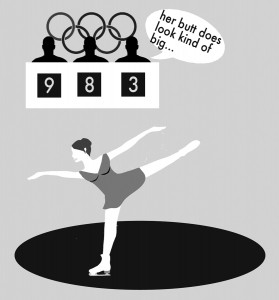Suggestive depictions of female Olympians trivialize athletics
In addition to the media buzz over Russia’s unfriendly policies toward gay people, the Winter Olympics also presents a biased view of female athletes. Photos of provocatively posed Russian athletes are being used to advertise the Sochi 2014 Winter Olympics, and went viral soon after their release, according to Slate. Though the website justified these images by reaffirming their support for their team, the decision to focus on female athletes’ figures demonstrates a much bigger problem — the way in which society trivializes female athletes.
These suggestive depictions hurt female athletes’ reputations and lead to less endorsements. A study published in the Journal of Brand Strategy emphasized that risqué depictions of female athletes is linked to the fact that they receive fewer endorsements than their male counterparts do. Though NBC dubbed figure skater Gracie Gold as the face of the Sochi Winter Olympics, she will most likely slip under the radar after the games conclude. The Huffington Post highlighted this point, adding that female athletic events are rarely televised and often occupy less-than-prime time slots. Despite the fact that marketers could argue that Gold is the face of this year’s Olympics, the stylized depictions of the figure skater make it hard for the public to see her as more than eye candy.
Unfortunately, using suggestive photos of women for marketing purposes is nothing new. From cars to fast food, ads regularly use racy images and language to entice consumers to open their pocketbooks. Though this type of hyper-sexualization seems to be the norm, it does not mean that it’s justifiable. Just as airbrushed ads overemphasize women’s bodies, these provocative photos present unrealistic expectations for women involved in sports. The images suggest that it is not enough for women to be Olympic athletes — they must also have supermodel-worthy bodies and exude sex appeal. This emphasis on suggestive marketing is a response to the “female gladiator” stereotype, or the idea that all women in sports are all testosterone-laden and unfeminine, according to Slate. The Russian marketing team picked up on this notion and claims the photos of lingerie-clad athletes show that “[the] Russian Olympic team defies stereotype that women in sport are just a heap of muscles and masculine shapes.” As with all generalizations, the “female gladiator” stereotype not only damages the perception of female athletes, but also encourages female athletes to take provocative photos. The focus should be on presenting a well-rounded depiction of athletes not using cheap marketing tactics as an attempt to advocate for women’s athleticism.
Even though Slate suggests that these provocative photos could help athletes “[come] alive as actual humans to cheer for,” these images objectify instead of humanize the women. After viewing these photo spreads, few people will take the time to research and acquaint themselves with the athletes’ personalities or histories. These pictures present a shallow depiction of the female Olympians and, if anything, make them seem less approachable. Not only are these women world-class athletes, but they also radiate sex appeal and can stand toe-to-toe with lingerie models. In order to “humanize” the athletes, the media should focus on speaking with them and allowing them to tell their narratives.
It is also illogical to equate photos of scantily-clad Olympians as a celebration of their athleticism. Though these athletes definitely deserve to be applauded for their athletic feats, they can be glorified without posing in lingerie. If these images are merely recognition of human achievements, why is it so difficult to find photos of male Olympians posed in a similar manner? Despite the fact that some male Olympians, such as the Italian freestyle skier Christof Innerhofer, pose in underwear ads, these photos are much harder to find and are not being used as marketing tools for the Olympic Games. If these provocative photos of Sochi female athletes truly “celebrate” athleticism, as some claim, there should be equal representation of male and female athletes.
Athletes clearly deserve to be celebrated, but they should be recognized without having to show skin. Yes, the Olympics should be a spectacle — just not the R-rated kind.
Veronica An is a sophomore majoring in narrative studies.


